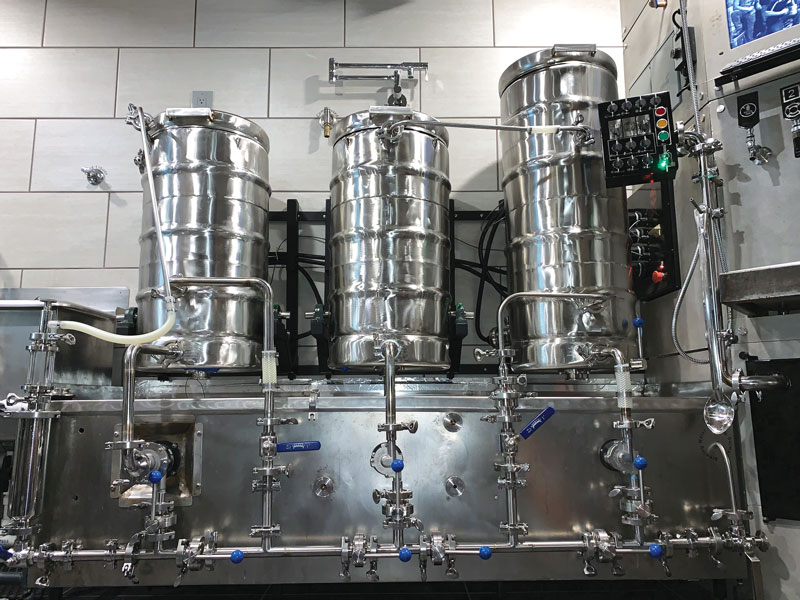Brewing Beer With Fresh-Picked Hops
TroubleShooting
Bill McMichael • New Castle, Delaware asks,
I’d like to ask you about post-boil use of fresh hops. I plan to brew a harvest beer from my backyard Chinook and Cascade this year. Using a general 5-to-1 ratio of fresh to dried hops, do you think I can obtain the same flavor/aroma benefit from fresh-picked hops in the whirlpool that I would get from dried hops? I’m thinking of adding them at 170 °F (77 °C).
Thanks for the fun question! This topic is a great reminder that beer has been brewed way longer than our scientific understanding of raw materials, brewing, and beer. It wasn’t long ago that landrace hops, or hop types indigenous to an area, were the norm. In these days, brewers knew very little about the brewing value of hops outside of where the hops were grown and the sensory attributes of the hops being tossed into the kettle or cask. Examples of landrace hops are Saazer, Hallertauer, Tettnanger, Spalter, and East Kent Golding. Brewers generously hopped beers with these regional hop types with no knowledge of hop chemistry until the early part of the 20th century. Yeah, less than 100 years ago.
OK, onto some practical thoughts. Your ratio of 5:1 for wet hops to dried hops is right in line with dry weight comparisons between the two types. Although hop drying does not result in appreciable losses of bittering acids or aromatics, both present in intact lupulin glands of whole hops, wet hops do have much more green and grassy flavors than their dried sisters. That’s neither a good nor bad thing, just a difference.
Wet hops also contain enzymes that can, and often do, create fun and interesting flavor changes in beer when added to the fermenter. Until recently, enzymatic activity in beer from hop enzymes had been lost to history. The wakeup call was due to the insane amount of dry hops that some of today’s craft brewers began adding to IPAs. Folks started noticing hop creep, wondered what the cause was, began doing research, and digging through the brewing literature. Like so much of history, the past hit the replay button. I’ll bring this back to the discussion in a moment.

To directly answer your question, I am gonna say “no.” Adding wet hops (fresh and unkilned) to your whirlpool will not give the same flavor and aroma as you would get from using kilned hops. In my mind, that’s a big plus because it differentiates these beers from beers brewed with a different hop product. Would it not be boring if using a different raw material had no noticeable effect on your beer?
Today’s brewers want to be able to calculate stuff. Why? Because there is so much available data just waiting to be popped into the number machine. But the calculator is hard to use when brewing with homegrown hops because the alpha content is rarely known. That’s cool; just use your homegrown hops for aroma. I like the idea of adding these wet hops to 170 °F (77 °C) wort because this temperature is hot enough to denature hop enzymes, but not so hot to isomerize alpha acids. What that means to the practical brewer is that you get aroma, hop flavor, little appreciable bitterness, and don’t need to worry about hop enzymes, specifically amyloglucosidase, that can change wort fermentability.
Some brewers may be thinking that those hop enzymes sound like a fun journey. And that’s where the diversity in brewing jumps into the mix. Another way to use your wet hops would be to dry hop with them. If you decided to go this route, consider limiting the contact time with beer because those green and grassy notes can be a bit extreme. A quick dry hop followed by racking off the dry hops or simply pulling the dry hop bag if a bag is used, will allow enough contact time with beer to extract hop aromas and enzymes, but gives the brewer a way of tempering the possibility of teasing out too much of the green flavors.
For anyone who decides to dry hop with fresh hops, this enzyme topic is more than academic. Hop enzymes convert unfermentable dextrins in beer into fermentable sugars, mainly glucose. If this happens in the package, the results can be volcanic. It also can cause a spike in diacetyl that may not fall below the sensory threshold if viable yeast concentration is too low. The takeaway is, if you plan on dry hopping a beer with wet hops plan for hop creep and allow things to happen before packaging.
Thanks again for the great question and have fun playing with your homegrown Cascade and Chinook hops!

